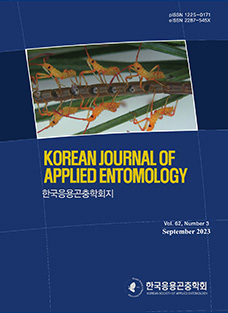점박이응애(Tetranychus urticae Koch)는 250과 1400여종의 식물에 피해를 주는 전 세계적으로 중요한 농업 해충이다(Kim et al., 2024). 점박이응애는 온대 및 열대 지역을 중심으로 한국, 중국, 일본, 유럽, 아프리카 등지에 서식하며, 특히 딸기에 심각 한 피해를 주는 주요 해충으로 알려져 있다(Choi et al., 2022;Abdelwines and Ahmed, 2022). 그 외에도 수박, 참외, 토마토, 오이, 고추, 가지, 장미 등 다양한 과채류 및 화훼류에 발생하여 피해가 보고되었다(Yu et al., 2005;Ilias et al., 2014).
점박이응애는 세대 기간이 짧고 번식력이 뛰어나 다른 해충에 비해 약제에 대한 저항성이 빠르게 발달하며(Riahi et al., 2013), 현재까지 개발된 대부분의 살비제에 대해 점박이응애의 저항성 발현이 보고되었다(Gavrilova et al., 2025). 이러한 약제 저항성의 빠른 발달은 화학적 방제의 효과를 저하시켜 농작물의 해충관리에 큰 어려움을 초래할 수 있다.
트랩식물은 해충으로부터 재배작물을 보호하기 위해 심겨지는 식물로써 해충의 서식지를 교란시켜 재배작물로 유입되는 것을 막거나, 해충을 방제하기 용이한 특정 구역으로 밀도를 집중시키는 역할을 한다(Choi et al., 2014). 최근 친환경 해충 방제 방법에 대한 관심이 높아짐에 따라 생물학적 방제에 기반한 트랩식물의 연구가 활발히 진행되고 있다. 예를 들어, 담배가루 이(Bemisia tabaci)의 트랩식물로 큰망초(Conyza sumatrensis) 가 선발되었으며(Choi et al., 2014), 미국선녀벌레(Metcalfa pruinosa)의 트랩식물로 해바라기가 사용된 사례도 있다(Choi et al., 2020). 또한 꽃노랑총채벌레(Frankliniella occidentalis) 의 트랩식물로 황색개화국화(Dendranthema morifolium)가 제시되었으며(Buitenhuis and Shipp, 2006;Choi et al., 2013), 이화명나방(Chilo suppressalis)의 트랩식물로 Vetiveria zizanioides이 사용된다(Lu et al., 2019).
점박이응애는 기주 범위가 매우 넓음에도 불구하고, 주로 콩과(Fabaceae) 식물을 선호하는 경향을 보인다(Yano et al., 1998;van den Boom et al., 2003). 특히 점박이응애는 콩의 수확량을 크게 감소시키며, 심한 경우 최대 100%의 손실을 초래할 수 있다(Khanjani and Haddad Irani-Nejad, 2006). 이러한 특성은 점박이응애를 효과적으로 방제하기 위한 전략으로 콩과식물을 점박이응애의 트랩식물로써 활용할 가능성을 시사한다. 그러나 점박이응애의 트랩식물 선정을 위해 다양한 콩과식물 종에 대한 점박이응애의 기주 선호도를 평가한 연구는 아직 충분히 이루어지지 않은 실정이다.
따라서 본 연구에서는 시중에서 쉽게 구입할 수 있는 콩과식물 10종을 대상으로 점박이응애의 기주 적합성과 기주 선호도를 평가하였다. 또한, 점박이응애의 유인이 확인된 기주식물에 대해 암조건에서의 유인 효과 및 딸기와의 유인 효과를 비교하는 실험을 수행하였다. 최종적으로 선발된 트랩식물의 초장에 따른 점박이응애의 유인력과 산란수를 조사하여 트랩식물로써의 활용 가능성을 평가하였다.
재료 및 방법
시험곤충
본 시험에 사용한 점박이응애는 2023년 3월에 경상남도농업기술원 농업해충연구실에서 15년 이상 살충제에 노출시키지 않으면서 사육한 개체를 분양받아 경상국립대학교 식물의학과 곤충사육실에서 누대사육하였다. 실내 사육조건은 온도 26 ± 1°C, 상대습도 60~70% RH, 광주기 16L : 8D이다. 신선한 강낭콩 모종을 주 3회 먹이로 제공하여 개체군을 유지하였고, 물이 담긴 베이스트레이에 강낭콩 모종 포트를 두어 점박이응애 이탈을 방지하였다. 실험에는 2–3일 된 점박이응애 암컷 성충을 사용하였다.
시험기주
본 연구에서는 시중에서 쉽게 구입 가능한 콩과식물 10종을 선정하였다(Fig. 1A–J). 실험에 사용된 콩과식물 10종의 학명, 일반명, 한글명, 원산지는 Table 1과 같다. 콩과식물에 대한 점 박이응애 선호성을 실내에서 검정하기 위해 경상국립대학교 식물의학과 사육실에서 온도 26 ± 1°C, 상대습도 60~70% RH, 광주기 16L : 8D 조건으로 콩과식물을 재배하였다.
콩과식물 기주 적합성 검정: two-choice test
콩과식물 10종에 대한 점박이응애의 유인력을 검정하기 위해 다리(bridge) 검정 방법을 설계하여 실험을 수행하였다(Fig. 2A). 두 개의 페트리디쉬(나비엠알오, H10060, 60 × 15 mm)에 증류수 7 ㎖이 분주된 탈지면(40 × 40 mm)을 깔고, 한 페트리디 쉬에는 시험기주 잎(40 × 40 mm)을 뒷면이 위를 향하게 올리고 다른 페트리디쉬에는 대조구로 아크릴판(40 × 40 mm)을 올렸 다. 시험기주 잎과 아크릴판을 다리(10 × 100 mm)로 연결하고, 다리 중앙에 점박이응애 암컷 30마리를 붓으로 접종하였다. 처 리 24시간 뒤, 각 페트리디쉬 안에 정착한 점박이응애 암컷의 개 체수와 산란된 알의 수를 현미경을 이용하여 조사하였다. 각 처 리는 방향성에 따른 점박이응애의 편향을 최소화하기 위해 시 험기주 잎과 대조구의 위치를 교대로 배치하여 3~7회 반복하여 실시하였다.
선발된 콩과 기주식물의 선호도 조사: multiple-choice test
콩과식물에 대한 점박이응애 기주 선호도를 조사하기 위해 적합성 검정 실험에서 설명된 다리 검정 방법을 변형하여 실험 하였다(Fig. 2B). 페트리디쉬(SPL, 310102, 100 × 40 mm)에 증류수 30 μl이 분주된 탈지면(10 × 10 mm)을 원 둘레(지름 70 mm)로 10개 깔고, 탈지면 위에 시험기주 9종의 잎(10 × 10 mm)과 대조구인 아크릴판(10 × 10 mm)을 각각 올렸다. 시험기주 9 종의 잎과 아크릴판을 정십각형 다리로 연결하고, 다리 중앙에 점박이응애 암컷 30마리를 붓으로 접종하였다. 처리 3시간 뒤, 각 식물 잎에 정착한 점박이응애 암컷의 개체수와 산란된 알의 수를 현미경을 이용하여 조사하였다. 각 처리는 방향성에 따른 점박이응애의 편향을 최소화하기 위해 시험기주 9종 잎의 위치 를 무작위로 배치하여 10회 반복하여 실시하였다.
선발된 콩과 기주식물의 암조건에서 유인력 검정: twochoice test
시각적 요인의 영향을 최소화하고 야간에도 지속적인 유인 효과를 유지할 수 있는 트랩식물을 선발하기 위해, 점박이응애의 기주 선호성을 암조건에서 평가하였다. 암조건에서 콩과 기주식물에 대한 점박이응애의 유인력을 검정하기 위해 앞서 콩과식물 기주 적합성 검정 실험에서 설명된 다리 검정 방법을 암 조건에서 동일하게 사용하였다(Fig. 2C). 두 개의 페트리디쉬에 증류수 7 ㎖이 분주된 탈지면을 깔고, 한 페트리디쉬에는 시험 기주 잎(40 × 40 mm)이 뒷면이 위를 향하게 올리고, 다른 페트 리디쉬에는 대조구로 아크릴판(40 × 40 mm)을 올렸다. 시험기 주 잎과 아크릴판을 다리로 연결하고, 빛이 없는 실험실 환경에 서 다리 중앙에 점박이응애 암컷 30마리를 붓으로 접종하였다. 암조건에서 처리 24시간 뒤, 각 페트리디쉬에 정착한 점박이응 애 암컷의 개체수와 산란된 알의 수를 현미경을 이용하여 조사 하였다. 각 처리는 방향성에 따른 점박이응애의 편향을 최소화 하기 위해 시험기주 잎과 대조구의 위치를 교대로 배치하여 4회 반복하여 실시하였다.
선발된 콩과 기주식물과 딸기와의 유인력 비교: twochoice test
선발된 콩과식물과 주요 기주인 딸기에 대한 점박이응애의 유인력을 비교하기 위해 앞서 콩과식물 기주 적합성 검정 실험에서 설명된 다리 검정 방법을 동일하게 사용하였다(Fig. 2D). 두 개의 페트리디쉬에 증류수 7 ㎖이 분주된 탈지면을 깔고, 한 페트리디 쉬에는 시험기주 잎을, 다른 페트리디쉬에는 딸기 잎을 뒷면이 위를 향하게 올렸다. 콩과식물과 딸기 잎을 다리로 연결하고, 다 리 중앙에 점박이응애 암컷 30마리를 붓으로 접종하였다. 처리 24시간 뒤, 각 페트리디쉬에 정착한 점박이응애 암컷의 개체수와 산란된 알의 수를 현미경을 이용하여 조사하였다. 각 처리는 방 향성에 따른 점박이응애의 편향을 최소화하기 위해 시험기주 잎 과 딸기 잎의 위치를 교대로 배치하여 6회 반복하여 실시하였다.
최종 선발된 트랩식물의 초장에 따른 유인력 비교: twochoice test on host plants
최종 선발된 트랩식물의 초장에 따른 점박이응애 유인력을 비교하기 위해 초장 150 mm 강낭콩 모종과 300 mm 강낭콩 모종에 대한 점박이응애 암컷의 선호성 반응을 조사하였다 (Fig. 2E). 초장 150 mm 강낭콩 모종과 300 mm 강낭콩 모종의 줄기 를 다리(105 × 230 mm)로 연결하였다(줄기 간 간격 170 mm). 종이 다리 가장자리에 끈끈이액을 도포하여 점박이응애 탈출을 방지하고, 다리 중앙에 점박이응애 암컷 30마리를 붓으로 접종 하였다. 처리 24시간 후, 각 강낭콩 잎에 정착한 점박이응애 암 컷의 개체수와 산란된 알의 수를 현미경을 이용하여 조사하였 다. 각 처리는 방향성에 따른 점박이응애의 편향을 최소화하기 위해 초장 150 mm 강낭콩 모종과 300 mm 강낭콩 모종의 위치 를 교대로 배치하여 6회 반복하여 실시하였다.
통계분석
콩과식물 기주 적합성 검정, 암조건에서 콩과식물 유인력 검 정, 콩과식물과 딸기 유인력 비교 및 선발된 트랩식물의 초장에 따른 유인력과 산란수 비교는 95% 신뢰수준에서 대응표본 t-검 정을 통해 분석하였다. 선발된 콩과 기주식물의 선호도 조사는 평균값을 일원분산분석 후 사후검정방법으로 Tukey’s HSD (Honest significant diffence) test를 5% 유의수준에서 비교하였 다. 모든 통계 분석은 SAS (Version 9.4, SAS Institute Inc.; Cary, USA)와 R-Studio ver. 2023.12.0 (R Studio Team, 2023) 통계프로그램을 이용하였다.
결과 및 고찰
콩과식물 기주 적합성 검정
콩과식물 10종에 대한 점박이응애 암컷의 유인력 및 산란수 를 조사하였다. 팥, 서리태, 서목태, 누에콩, 강낭콩, 녹두, 완두 콩, 땅콩, 작두콩에서 대조구인 아크릴판보다 유의하게 높은 점 박이응애의 유인이 확인되었다(팥: t = 5.91; df = 6; P = 0.001; 서리태: t = 5.40, df = 5, P = 0.002; 서목태: t = 5.91; df = 3; P = 0.009; 누에콩: t = 8.01; df = 3; P = 0.004; 강낭콩: t = 7.15; df = 3; P = 0.005; 녹두: t = 3.21; df = 4; P = 0.032; 완두콩: t = 8.97; df = 3; P = 0.002; 땅콩: t = 5.63; df = 3; P = 0.011; 작두콩: t = 29.00; df = 2; P = 0.001)(Fig. 3A, B, C, E, F, G, H, I, J). 반면 병 아리콩에는 점박이응애가 한마리도 유인되지 않았다(t = -23.44; df = 3; P = 0.0002)(Fig. 3D).
콩과식물 10종의 유인력 검정 결과와 동일하게, 점박이응애 의 산란이 팥, 서리태, 서목태, 누에콩, 강낭콩, 녹두, 완두콩, 땅 콩, 작두콩에서 대조구인 아크릴판보다 유의하게 높게 확인되었 다(팥: t = 16.88; df = 6, P < 0.0001; 서리태: t = 7.23, df = 5, P = 0.0008; 서목태: t = 13.33, df = 3, P = 0.0009; 누에콩: t = 10.6; df = 3; P = 0.002; 강낭콩: t = 7.33; df = 3; P = 0.005; 녹두: t = 5.65; df = 4; P = 0.005; 완두콩: t = 20.52; df = 3; P = 0.0003; 땅 콩: t = 5.18; df = 3; P = 0.014; 작두콩: t = 8.54; df = 3; P = 0.003)(Fig. 4 A–J). 반면 병아리콩에서는 점박이응애의 알이 전혀 확인되지 않았다(t = -5.36; df = 3; P = 0.013)(Fig. 4D).
점박이응애는 대부분의 콩과식물을 선호하는 것으로 추측된 다. 본 연구에서 사용된 콩과식물 외에도, 점박이응애는 리마콩 (Phaseolus lunatus), 동부(Vigna unguiculata), 금사실나무 (Laburnum anagyroides), 아까시나무(Robinia pseudoacacia), Vicia ervilia 등 여러 콩과식물에 강한 기주 선호성이 보고되었 다(Yano et al., 1998;van den Boom et al., 2003;Farazmand et al., 2015). 또한, 점박이응애는 콩과식물을 먹이로 제공하였을 때 정상적으로 발육하였으며(Najafabadi et al., 2014;Uddin et al., 2015;Abou-Elella and Abdel-Khalek, 2020), 이러한 이유 로 점박이응애 실내 누대사육 시 콩과식물을 주 기주식물로 사 용하고 있다(Roh et al., 2013;Lee et al., 2022).
또한 점박이응애의 선호성 및 산란 여부가 확인되지 않은 병 아리콩의 잎은 크기가 약 5 × 10 mm 정도로 매우 작으며, 잎 뒷 면에 빼곡히 분포하는 잎 분비모(leaf trichome)에 이슬이 다량 으로 맺히는 것이 관찰되었다. 이는 물에 취약한 점박이응애가 서식하기에 적합하지 않은 환경을 제공하는 것으로 판단된다. 또한 점박이응애는 다양한 사과 품종 중에서 분비모의 밀도가 낮은 잎보다 밀도가 높은 잎에서 이동성이 감소하는 경향을 보 였으며(Warabieda and Solomon, 2003), 강낭콩 품종 중에서 잎 분비모의 밀도가 높은 품종일수록 점박이응애의 산란수가 낮게 나타났다(Shoorooei et al., 2018). 이는 식물체 잎의 물리적 특 성이 점박이응애의 서식과 번식에 중요한 영향을 미칠 수 있음 을 시사한다. 또한 물리적 요인 외에도, 병아리콩의 추출물은 팥 바구미(Callosobruchus chinensis), 쌀바구미(Sitophilus oryzae), 거짓쌀도둑거저리(Tribolium castaneum)에 대한 살충 효과가 보고되었다(Asif et al., 2022). 따라서 병아리콩의 물리적 특성 과 살충 효과를 종합적으로 고려할 때, 병아리콩은 점박이응애 의 기주로써 적합하지 않은 것으로 판단된다.
선발된 콩과 기주식물의 선호도 조사
콩과식물 기주 적합성 검정 실험에서 기주로 선발된 팥, 서리 태, 서목태, 누에콩, 강낭콩, 녹두, 완두콩, 땅콩, 작두콩에 대한 점박이응애 암컷의 기주 선호도를 조사하였다. 점박이응애 유 인수는 강낭콩에서 가장 많았으며, 다음은 서리태>팥>누에콩> 서목태>작두콩>완두콩>땅콩>녹두>아크릴판 순으로 나타났 다(F = 6.82; df = 9, 90; P < 0.0001)(Fig. 5A).
점박이응애 산란수는 강낭콩에서 가장 많았으며, 다음은 서 리태>서목태>팥>누에콩>완두콩>작두콩>녹두 순으로 나타났 다. 하지만 땅콩과 아크릴판에서는 점박이응애의 산란이 확인 되지 않았다(F = 7.37; df = 9, 90; P < 0.0001)(Fig. 5B).
점박이응애는 콩과식물에 따라 선호도 차이가 나타났다. Farazmand et al. (2015)에 따르면 점박이응애는 기주의 영양 성 분과 독성 성분의 차이에 따라 선호성이 다르게 나타난다고 보 고되었다. 따라서 콩과식물에 대한 점박이응애의 선호도 차이 의 원인을 규명하기 위해, 콩과식물의 영양 성분과 독성 성분을 분석하는 추가 연구가 필요하다.
선발된 콩과 기주식물의 암조건에서 유인력 검정
상기 콩과 기주식물의 선호도 조사 실험에서 점박이응애의 기주 선호도가 높았던 팥, 서리태, 강낭콩에 대한 점박이응애 암 컷의 유인력 및 산란수를 암조건에서 조사하였다. 상기 결과와 동일하게 암조건에서 점박이응애 암컷이 대조구인 아크릴판보 다 팥, 서리태, 강낭콩에 유의하게 높은 수준으로 유인되는 것이 확인되었다(팥: t = 9.18, df = 3, P = 0.002; 서리태: t = 51.70, df = 3, P < 0.0001; 강낭콩: t = 11.77, df = 3, P = 0.0013)(Fig. 6A, B, C). 또한 암조건에서 점박이응애 암컷의 산란이 대조구인 아 크릴판보다 팥, 서리태, 강낭콩에서 유의하게 높게 확인되었다 (팥: t = 11.24, df = 3, P = 0.0015; 서리태: t = 13.93; df = 3; P = 0.0008; 강낭콩: t = 16.84; df = 3; P = 0.0005)(Fig. 6D–F).
점박이응애는 암조건에서도 유인 및 산란 행동이 확인되었 다. 이는 점박이응애가 시각적 요소 없이도 기주를 탐색할 수 있 으며, 후각적 신호가 기주를 선택하는데 중요한 역할을 한다는 사실을 입증한다. 본 연구 결과와 유사하게, 점박이응애는 리마 콩과 딸기의 휘발성 물질에 대한 유인 반응이 보고되었으며, 이 는 점박이응애가 후각적 신호를 사용하여 기주를 선택한다는 것 을 시사한다(Horiuchi et al., 2003;Mérida-Torres et al., 2023).
선발된 콩과 기주식물과 딸기와의 유인력 비교
점박이응애의 기주 선호도가 높았던 팥, 서리태, 강낭콩 각각 에 대한 점박이응애 암컷의 유인력 및 산란수를 딸기와 비교하 였다. 팥과 딸기, 그리고 서리태와 딸기에 대한 점박이응애 암컷 의 유인력은 유의미한 차이가 확인되지 않았다(팥: t = 0.81; df = 5; P = 0.453; 서리태: t = 0.93; df = 5; P = 0.395)(Fig. 7A, B). 반면 강낭콩은 딸기보다 점박이응애 암컷의 유인력이 3배 더 높 은 경향을 보였다(t = 2.84; df = 5; P = 0.036)(Fig. 7C).
점박이응애 암컷의 산란수는 팥과 딸기에서 큰 차이가 나타 나지 않았으며(t = 0.25; df = 5; P = 0.815)(Fig. 7D), 서리태는 딸기보다 산란수가 약 2배 낮은 경향을 보였으나 유의미한 차이 가 확인되지 않았다(t = -1.30; df = 5; P = 0.252)(Fig. 7E). 반면 강낭콩은 딸기보다 산란수가 3배 더 높은 경향을 보였다(t = 2.76; df = 5; P = 0.04)(Fig. 7F).
본 연구 결과와 유사하게, Yano et al. (1998)에 따르면 강낭콩 과 딸기를 포함한 약모밀(Houttuynia cordata), 소리쟁이(Rumex crispus), 서양민들레(Taraxacum officinale) 등 11가지 식물에 대한 점박이응애의 정착 행동 및 산란 실험 결과, 딸기보다 강낭 콩에서 높은 기주선호성이 확인되었다. 따라서 점박이응애의 트 랩식물로써 강낭콩을 사용하는 것이 가장 효과적일 것으로 판단 된다.
최종 선발된 트랩식물의 초장에 따른 유인력 비교
트랩식물로 최종 선발된 강낭콩의 초장에 따른 점박이응애 암컷의 유인력 및 산란수를 조사하였다. 점박이응애 암컷은 강 낭콩 150 mm 모종보다 300 mm 모종에 더 많이 유인 및 산란하 는 경향을 보였으나 유의미한 차이는 나타나지 않았다(유인력: t = -2.27; df = 5; P = 0.072, 산란수: t = -1.84; df = 5; P = 0.125) (Fig. 8A, B).
식물의 초장에 따른 점박이응애의 기주 선호성은 현재까지 밝 혀지지 않은 것으로 추측된다. 본 결과와 비슷하게 담배가루이는 트랩식물인 가지의 초장이 클수록 유인 효과가 높게 나타났으며, 이는 담배가루이가 후각적인 반응보다 시각적인 반응에 더 민감 하게 반응하여 기주를 선택하는 경향을 보인다고 제시하였다 (Choi et al., 2015). 반면 점박이응애는 상기 암조건에서 진행된 유인 실험 결과를 통해 시각적인 반응보다 후각적인 반응에 더 민 감하다는 것이 확인되었으며, 이는 강낭콩이 생장하면서 초장이 커질수록 방출되는 휘발성 물질의 종류 및 휘발성 물질의 양이 변 화하여 점박이응애가 더욱 강하게 유인되는 것으로 추측된다.
점박이응애는 채소, 과수, 화훼 등 약 1,400 종의 작물에 피해 를 주는 전세계적으로 중요한 해충으로, 짧은 발육 세대로 인한 저항성 발현 문제 등으로 기존 살충제 중심의 방제 방법으로는 효과적인 관리가 어려운 실정이다. 이에 따라 지속 가능한 방제 전략으로 트랩식물이 주목받고 있으며, 이는 해충을 유인하여 작물을 보호함으로써 무분별한 농약 사용을 최소화하고 낮은 비용으로 효과적인 해충 관리가 가능하도록 한다. 또한 트랩식 물은 천적의 서식지를 제공하여 생물적 방제를 촉진할 뿐만 아 니라, 해충의 분포나 밀도를 예찰할 수 있다.
본 연구에서는 점박이응애 방제를 위한 트랩식물로 콩과식 물에 대한 기주 적합성 및 선호성을 조사하였고, 최종적으로 딸 기에 대한 점박이응애의 유인력 및 산란수를 비교하여 최적의 트랩식물을 선발하였다. 연구 결과, 점박이응애는 딸기보다 강 낭콩에 효과적으로 유인되었으며, 강낭콩에 점박이응애가 많이 유인됨에 따라 산란수도 증가하는 것으로 나타났다. 이러한 결 과는 점박이응애가 강낭콩에 일시적으로 유인되는 것이 아니 라, 강낭콩이 점박이응애의 생존과 산란이 가능한 기주식물임 을 시사한다. 이는 재배 작물로 유입되는 점박이응애의 개체수 뿐만 아니라 산란수도 감소시킴으로써 추후 재배 작물에 발생 하는 점박이응애의 밀도가 감소될 것으로 예상된다.
점박이응애는 초장 150 mm 강낭콩보다 300 mm 강낭콩을 선호하는 경향을 보였지만 유의미한 차이는 나타나지 않았다. 실험실 환경에서 초장 300 mm 이상의 강낭콩을 재배 및 실험에 사용하였을 때, 강낭콩 줄기가 쓰러지는 문제가 발생하여 트랩 식물로써의 실용성이 낮을 것으로 판단된다. 또한 트랩식물의 실용화를 위해서는 온도, 습도 등 다양한 환경 요인과 생물학적 요인이 복합적으로 작용하는 실제 작물 재배지 조건에서의 검 증이 필요하다. 이에 따라, 향후 초장이 300 mm 이하인 강낭콩 을 사용하여 야외 환경에서 트랩식물의 설치 간격 및 교체 시기 를 최적화하는 추가적인 연구를 진행할 예정이다.
또한 작물 재배지에서 트랩식물을 사용할 경우, 점박이응애 번식에 유리하게 작용하여 재배 작물로의 점박이응애 이차 확 산이 발생할 가능성이 있다. 이를 방지하기 위해, 재배 작물 주 변에 점박이응애의 기피제 설치와 천적 사용을 병행함으로써 점박이응애 방제 효과를 극대화시킬 수 있는 추가적인 연구가 필요하다. Choi et al. (2013)에 따르면 트랩식물과 천적을 병행 하여 사용할 경우 꽃노랑총채벌레의 개체군 밀도가 효과적으로 감소되는 것으로 보고되었다. 본 연구 결과는 점박이응애 방제 를 위한 새로운 전략으로 트랩식물 활용 가능성을 제시함으로 써, 친환경적이고 지속 가능한 점박이응애 방제 전략을 수립하 는데 중요한 기초 자료로 이용될 것으로 기대된다.

















 KSAE
KSAE





